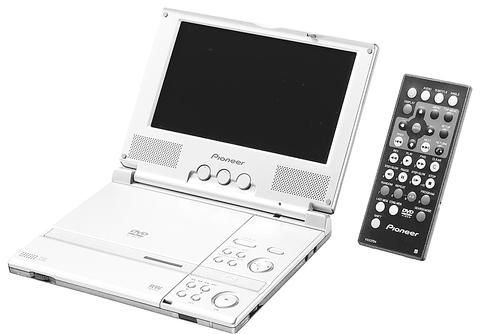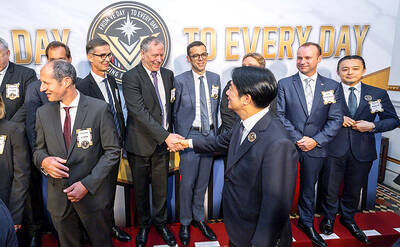Air travel these days is no joy ride. The lines are long, the flights are late and only middle seats remain. And if that's not enough to give you air rage, just wait until the in-flight movie begins -- on a 23cm TV that's 5m away, with a soundtrack piped through plastic tubes into disposable headphones. It's enough to give filmmakers fear of flying.
For the discerning videophile, a far superior option is at hand: personal DVD players. With their slim, silvery, high-tech looks, they could easily be mistaken for Sony Vaio microlaptops from the year 2015. But these compact machines don't do Windows. They simply play DVDs (and CDs), with delicious clarity and brilliance.
If you must justify the expenditure to a skeptical spouse, emphasize that a portable DVD player does much more than serve as a flashy, private, in-flight cineplex. Point out that these gadgets double as traditional DVD players, complete with remote control, when hooked up to your television.

PHOTO: NY TIMES
Make the point, too, that during long drives, a portable DVD player is the ultimate "Are we there yet?" silencer for back-seat youngsters. And observe pragmatically that most also play music CD's, video CD's, MP3 files on CD-R or CD-RW discs and just about anything else that's flat, round and shiny.
If you're successful with your pitch, you'll be well rewarded. It's virtually impossible to open up one of these babies without uttering "Aw, cool!" (or your generation's equivalent thereof).
The first thing that hits you is that the screen is wide, not square. If you love movies, this is a big deal; after all, when you watch most movies on a square television, the sides of the screen chop off a third of the picture.
When you watch a DVD on one of these portable players, you see every millimeter of the picture the director worked so hard to frame, exactly as in a movie theater.
Of course, a real theater screen is a tad larger than a portable DVD player's screen, which is roughly the size of the Zagat restaurant guide turned sideways. But at only 50cm from your eyes, a movie fills almost the same amount of your field of view -- and nobody ever blocks your view.
When trying to describe these players' small stereo speakers, "bone-rattling" doesn't spring to mind. In fact, the ambient noise of a plane, train or automobile is enough to drown out most of the dialogue.
But these players' headphone jacks offer rich, high fidelity and, if you like, even simulated surround sound. And if you, a hard-core home-entertainment nut, own a Dolby or DTS system (and the corresponding six-speaker setup), these DVD players can pump out the same six channels of pristine sound that you'd hear in the theater.
Panasonic's LV-60 is the smallest DVD player you can buy; as you hook up your headphones on the way to Kansas City, your seatmate is sure to believe that this six-inch-square gizmo a simple CD player. That's when you smile smugly, flip up its lid and reveal the small but extremely bright and crisp screen (measuring 14.7cm diagonally).
The LV-60s list price is US$800, but don't believe it. Thanks to a rip in the time-space continuum, or something, portable DVD players actually cost hundreds less than the suggested price. A quick search on Dealtime.com, for example, shows that US$600 is the LV-60s street price.
The next step up from the LV-60 is the Panasonic LV-70 (US$900 list, US$650 street), which offers a 17.7cm screen and a larger case and doesn't read as many disc formats as the LV-60. Despite its larger size, the picture isn't nearly as good as on its smaller sibling; it's somehow oversharpened. Close-ups reveal what seem to be tiny blemishes even on Nicole Kidman, which we all know is impossible.
The two Panasonic machines offer bigger sound than their rivals -- in fact, at top volume, their sound is distorted during loud scenes. Still, during soft moments, it's nice to have that extra sonic boom up your sleeve.
It's just too bad that each Panasonic model comes with only one headphone jack (their rivals have two); sharing a movie with someone next to you is often half the fun.
If you're looking for a 17.7cm screen, the beautiful Pioneer PDV-LC20 (US$1,545 list, US$770 street) is a better bet. With its sleek, superthin design and cool silver-blue finish, it's the DVD player most likely to increase your heart rate before you've even turned it on.
Nor is the physical design the only standout feature. This model has the only battery you can charge when it's detached from the player -- good news if you buy a second battery. Furthermore, three dedicated buttons adjust brightness, color saturation and screen shape (wide screen or TV square); why on earth should such often-adjusted controls be buried in on-screen menus?
This model can automatically remember your picture and parental-control settings for 15 different discs. As icing on the cake, Pioneer provides a superb manual.
But something is going on with this player's glossy screen, which seems to use a different technology than the matte-finish screens of the other players. It grants you a much wider viewing angle and a smoothed picture -- precisely the opposite of the oversharpened effect on the Panasonic LV-70 -- but a very subtle yellow cast.
(You wouldn't even notice these differences, by the way, without watching the same movie on side-by-side players, which is precisely what I did. I went to Blockbuster and rented four copies each of Gladiator, Cliffhanger and The Matrix. The guy behind the counter thought I needed psychiatric help.)
Toshiba's SD-P1500 is the only player reviewed here with an 20.3cm screen. It's also the only one that looks exactly like a movie screen: not too sharp, blurry, yellow or anything else but great.
Nor is that the only attraction for film connoisseurs. Most people connect DVD players to their televisions using either a composite-video cable (which ends in three small, round, color-coded connectors) or, for slightly better color detail, an S-video cable (which fits a dime-size socket on recent sets).
Only Toshiba's player offers a third connector called component video; its three-headed cable fits special jacks labeled Y, Cb and Cr on the latest, 68.5cm-plus televisions, for the ultimate video quality.
The price you pay for this video-quality heaven is US$800 street (US$1,200 list) and a lot of bulk. At 16cm by 21cm (and, with its almost equally massive slip-underneath battery pack, about 5cm thick), this model creeps dangerously close to laptop territory. Only you can determine whether its relatively huge, nearly perfect picture is worth its bulk.
All portable DVD players, it should be noted, share certain deficiencies.
For example, each offers a raft of silly features in cramped menus; how often will you want to randomize the order of movie scenes, loop one scene endlessly or flip the image upside down? (I take it back; I can remember a couple of Schwarzenegger flicks that might have benefited from such treatment.)
Note, too, that the batteries are big, bulky, clip-on affairs that -- caveat emptor -- are never shown in the photos of these players.
Yet even with all that heft, the Panasonic LV-60 and LV-70, Pioneer and Toshiba batteries run for only about 3, 4, 3 and 3.5 hours, respectively. (Extra-cost, extra-heft batteries are available, too.)
Fortunately, battery life improves with each year's round of personal DVD-player models.
The screens are growing, too; later this year, Panasonic will release a player with a 22.8cm screen.
At that point, you'll be ready for business. You can sell US$5 headsets to passengers who want to watch your in-flight movie.

DEFENDING DEMOCRACY: Taiwan shares the same values as those that fought in WWII, and nations must unite to halt the expansion of a new authoritarian bloc, Lai said The government yesterday held a commemoration ceremony for Victory in Europe (V-E) Day, joining the rest of the world for the first time to mark the anniversary of the end of World War II in Europe. Taiwan honoring V-E Day signifies “our growing connections with the international community,” President William Lai (賴清德) said at a reception in Taipei on the 80th anniversary of V-E Day. One of the major lessons of World War II is that “authoritarianism and aggression lead only to slaughter, tragedy and greater inequality,” Lai said. Even more importantly, the war also taught people that “those who cherish peace cannot

Taiwanese Olympic badminton men’s doubles gold medalist Wang Chi-lin (王齊麟) and his new partner, Chiu Hsiang-chieh (邱相榤), clinched the men’s doubles title at the Yonex Taipei Open yesterday, becoming the second Taiwanese team to win a title in the tournament. Ranked 19th in the world, the Taiwanese duo defeated Kang Min-hyuk and Ki Dong-ju of South Korea 21-18, 21-15 in a pulsating 43-minute final to clinch their first doubles title after teaming up last year. Wang, the men’s doubles gold medalist at the 2020 and 2024 Olympics, partnered with Chiu in August last year after the retirement of his teammate Lee Yang

The Philippines yesterday criticized a “high-risk” maneuver by a Chinese vessel near the disputed Scarborough Shoal (Huangyan Island, 黃岩島) in a rare incident involving warships from the two navies. The Scarborough Shoal — a triangular chain of reefs and rocks in the contested South China Sea — has been a flash point between the countries since China seized it from the Philippines in 2012. Taiwan also claims the shoal. Monday’s encounter took place approximately 11.8 nautical miles (22km) southeast” of the Scarborough Shoal, the Philippine military said, during ongoing US-Philippine military exercises that Beijing has criticized as destabilizing. “The Chinese frigate BN 554 was

US Secretary of the Treasury Scott Bessent and US Trade Representative Jamieson Greer began talks with high-ranking Chinese officials in Switzerland yesterday aiming to de-escalate a dispute that threatens to cut off trade between the world’s two biggest economies and damage the global economy. The US delegation has begun meetings in Geneva with a Chinese delegation led by Chinese Vice Premier He Lifeng (何立峰), Xinhua News Agency said. Diplomats from both sides also confirmed that the talks have begun, but spoke anonymously and the exact location of the talks was not made public. Prospects for a major breakthrough appear dim, but there is